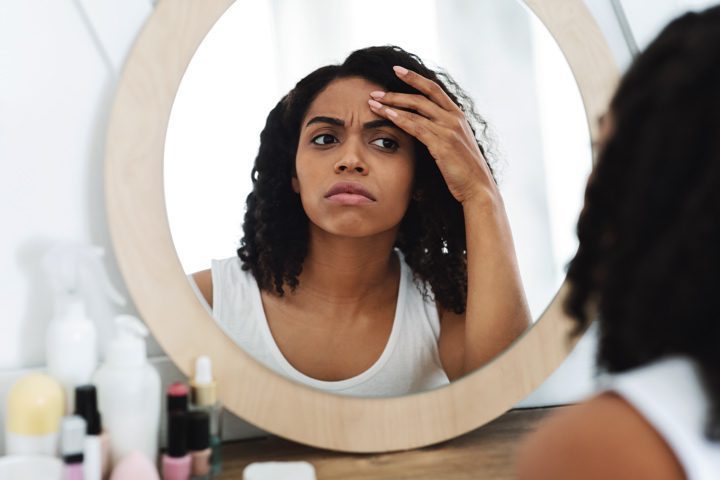
Everyone has days when they don’t feel they look their best, or wish they didn’t have a scar or some other type of flaw in their appearance. So when do these feelings actually become a problem? Body dysmorphia, also referred to as body dysmorphic disorder (BDD), is a mental health condition defined by someone’s emotional distress and obsessive compulsive behavior regarding body image. Frequently, an individual who suffers with an eating disorder also has BDD.
How People Perceive Body Image
According to Break Binge Eating.org, body image is defined as, “a multifaceted concept comprised of perceptual (i.e., how we think we look), attitudinal (i.e., how we evaluate our body), and behavioral (i.e., our actions toward our body) components.”
This means if a person has negative thoughts about their appearance, even if it’s unfounded, they’ll be more likely to do whatever they have to in order to change. A perception of a “perfect” body image is often driven by:
- Societal influences such as media and gender-stereotypical roles.
- Other peoples’ ideation of how certain looks create success.
- Body comparisons to others, especially fashion models or body builders.
- “Fat talk” that reinforces a negative self-image.
- Perfectionism in all areas of life, especially if the idea of perfection equates to love and acceptance.
More Information
Here are some interesting points by Do Something.org, the National Eating Disorders Association (NEDA), and ABC News:
- People who have a negative body image and “don’t seek healthy nutrition information” have a higher risk of developing eating disorders, which might include “fasting, constant dieting, or binging and purging.”
- An average of one in three people with eating disorders also had challenges with obsessive compulsive symptoms.
- Only 5 percent of women in the U.S. have the body type that is so often portrayed in the media.
- More than 40 percent of girls ages 7–10 want to lose weight.
- “Up to 40 percent of overweight girls and 37 percent of overweight boys are teased about their weight by peers or family members.”
- Roughly 70 percent of women and men between the ages of 18–30 don’t like their bodies.
- Approximately 20 percent of men and over 40 percent of women would consider cosmetic surgery to alter their appearance.
- Nearly 40 percent of men in the U.S. “who binge eat experience depression.”
- The social media platform Instagram pulled its plastic surgery filter due to concerns about teens’ self-image issues, and blocked content “promoting weight loss or cosmetic procedures to people under 18, especially those that make ridiculous claims about weight loss.”
- “Approximately one in four people with an eating disorder has symptoms of post-traumatic stress disorder (PTSD).”
NEDA also cites a survey of approximately 2,400 people hospitalized with eating disorders. Results indicated that nearly all of these individuals also have “one or more co-occurring conditions,” including major depression, self-harm, anxiety, obsessive-compulsive disorder, PTSD, and alcohol or substance use disorder.
Symptoms of Body Dysmorphia
The main difference between someone who doesn’t like the way they look on a particular day and BDD involves preoccupation with a visual perception. Few people notice our flaws as much as we do, but someone who has BDD has difficulty letting go of them and believe they’re being judged as a result of them.
Certain obsessive-compulsive behaviors typical of BDD behavior include:
- Constant comparison to other people
- Frequently using additional clothing, body positioning, or posture to hide perceived flaws
- Looking at their supposed flaws in mirrors multiple times a day, or conversely, avoiding reflective surfaces because of feelings of disgust or shame about appearance
- Defaulting to “reassurance-seeking” as a coping mechanism by asking other people questions about appearance
- Frequently picking at skin with tweezers or fingers
More extreme symptoms of BDD might involve:
- Excessive and frequent cosmetic or dermatological procedures to “fix” or remove alleged problems.
- Only going out at night to avoid being seen in public, or refusing to attend school, social gatherings, or work.
Just like people with eating disorders, individuals suffering with BDD often experience co-occurring disorders such anxiety, depression, low self-esteem, and suicidal thoughts.
Healing BDD From the Inside
There’s no denying that the healing process for BDD involves a great deal of focused, internal work, but it’s well worth the effort. Most treatment plans include some form of cognitive behavioral therapy to help a person not only understand the origin of their body dysmorphia issues but also learn numerous ways for correcting their negative perceptions with affirmation and positive self-reinforcement.
If people have co-occurring disorders such as depression or anxiety, some therapists might also recommend specialized treatment for those conditions to provide them with more stability to address BDD.
Realistic support and encouragement are also helpful for people recovering from BDD. They learn to trust that their network will offer the right guidance and camaraderie to help them avoid triggers and overcome feelings of low self-worth.
Going Beyond the Outside
Cottonwood Tucson’s approach to effectively treating body dysmorphia and eating disorders involves whole person assessments. These thorough examinations of mental, emotional, physical, and spiritual health allow our board-certified professionals to move beyond the surface to design highly-personalized treatments that address many factors. Learn more about our comprehensive individual evaluations.
Resources







